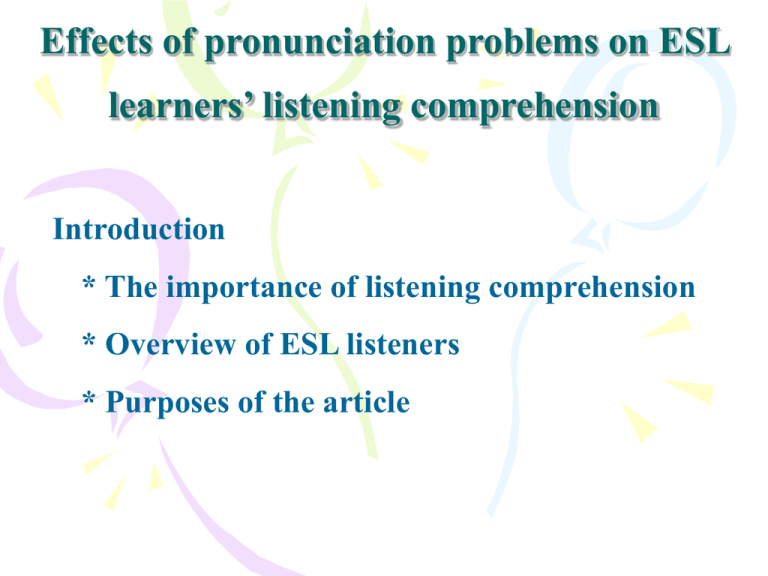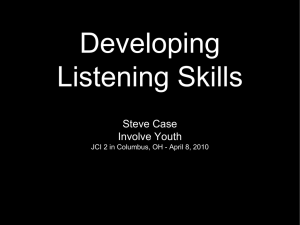Effects of pronunciation problems on ESL learners` listening
advertisement

Effects of pronunciation problems on ESL learners’ listening comprehension Introduction * The importance of listening comprehension * Overview of ESL listeners * Purposes of the article Understanding students’ listening problems * Learners’ listening difficulties related to perception, parsing, and utilization * Common problems at the perception stage: pronunciation problems Discussion 1. Problems related to perception * Problem 1: Fail to recognize words they know - know the word but attributed the wrong sense Ex: won’t & want I won’t go to school / I want to go to school went to assist a passenger a student extracts sister - fail to recall familiar words immediately Ex: fortnight, retrieve, procedure, mature, etc. * Reasons: - affect from the habit of learning words + recognize words by sight not by sound + learn words with incorrect pronunciations + fail to recognize phonetic variations of known words + affect from listener’s L1 (word-final consonant discrimination) - under-achieve listening vocabulary Problem 2: Neglect the next part of the continuous speech when thinking about meaning -miss the next part of the text to think about unfamiliar words or interpret of a segment of text - affect learners’ concentration on listening texts * Reasons: + fail to process the information fast enough + fail to recognize familiar words in the stream of speech. Possible listening strategies * Direct strategy: perception and strategy practice - Perception practice: + Listen to how new vocabulary items are pronounced + Follow along with transcript of recording + Write down content words from short passages * Cognitive tactics: + Infer missing or unfamiliar words using contexts, co-text and prior knowledge + Predict general contents before listening using contexts and prior knowledge + Predict unfinished utterances using contexts, co-text and prior knowledge + Relate one part of the text to another * Metacognitive tactics + Preview contents in different forms + Rehearse the pronunciation of potential content words + Establish purpose of listening + Listen selectively according to purpose + Pay attention to tones and pauses * Metacognitive tactics + Continue to listen for clarification in spite of difficulty + Assess the importance of problematic parts and decide whether to ignore them or actively seek clarification + determine the potential value of subsequent parts and vary intensity of attention accordingly * Social-affective tactics + Learn to relax before and during listening + Encourage oneself to continue listening * Indirect strategy: metacognitive awareness + Set aside lesson time for discussion and reports about listening problems and useful strategies + Encourage students to ‘think aloud’ soon after they have completed a listening task + Provide opportunities for individual reflection through listening diaries + Extend the scope of pre-listening and postlistening tasks to include metacognitive tasks (Goh, 2000) Conclusion






